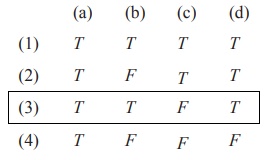Discrete Mathematics | Mathematics - Exercise 12.3: Choose the correct answer | 12th Maths : UNIT 12 : Discrete Mathematics
Chapter: 12th Maths : UNIT 12 : Discrete Mathematics
Exercise 12.3: Choose the correct answer
EXERCISE 12.3
Choose the correct or the most suitable answer from the given four alternatives.
1. A binary operation on a set S is a function from
(1) S → S
(2) (S×S)→ S
(3) S →(S×S)
(4)(S×S)→(S×S)
2. Subtraction is not a binary operation in
(1) ℝ
(2) ℤ
(3) ℕ
(4) ℚ

3. Which one of the following is a binary operation on ℕ?
(1) Subtraction
(2) Multiplication
(3) Division
(4) All the above
4. In the set ℝ of real numbers ‘ * ’ is defined as follows. Which one of the following is not a binary operation on ℝ ?
(1) a ∗ b = min (a×b)
(2) a ∗ b = max (a, b)
(3) a ∗ b = a
(4) a ∗ b = ab

5. The operation * defined by a ∗ b = ab/7 is not a binary operation on
(1) ℚ+
(2) ℤ
(3) ℝ
(4) C

6. In the set ℚ define a ![]() b = a +b +ab . For what value of y, 3
b = a +b +ab . For what value of y, 3 ![]() ( y
( y ![]() 5)= 7 ?
5)= 7 ?
(1) y = 2/3
(2) y = −2/3
(3) y = −3/2
(4) y = 4

7. If a ∗ b = √(a2 +b2) on the real numbers then * is
(1) commutative but not associative
(2) associative but not commutative
(3) both commutative and associative
(4) neither commutative nor associative

8. Which one of the following statements has the truth valueT ?
(1) sin x is an even function.
(2) Every square matrix is non-singular
(3) The product of complex number and its conjugate is purely imaginary
(4) √5 is an irrational number
9. Which one of the following statements has truth value F ?
(1) Chennai is in India or √2 is an integer
(2) Chennai is in India or √2 is an irrational number
(3) Chennai is in China or √2 is an integer
(4) Chennai is in China or √2 is an irrational number
10. If a compound statement involves 3 simple statements, then the number of rows in the truth table is
(1) 9
(2) 8
(3) 6
(4) 3

11. Which one is the inverse of the statement ( p ∨ q ) → ( p ∧q) ?
(1) ( p ∧ q ) → ( p ∨q)
(2) ¬( p ∨q ) → ( p ∧q)
(3) (¬ p ∨¬ q ) → (¬ p ∧¬q)
(4) (¬ p ∧¬ q ) → (¬ p ∨¬q)

12. Which one is the contrapositive of the statement ( p ∨ q ) → r ?
(1) ¬ r → (¬ p ∧¬q)
(2) ¬ r → ( p ∨q)
(3) r → ( p ∧q)
(4) p → ( q ∨r)

13. The truth table for ( p ∧ q ) ¬q is given below

Which one of the following is true?

Answer: (3)

14. In the last column of the truth table for ¬ ( p ∨¬q) the number of final outcomes of the truth value ' F ' are
(1) 1
(2) 2
(3) 3
(4) 4

15. Which one of the following is incorrect? For any two propositions p and q , we have
(1) ¬ ( p ∨ q) ≡ ¬p ∧¬q
(2) ¬ ( p ∧ q) ≡ ¬p ∨¬q
(3) ¬ ( p ∨ q) ≡ ¬p ¬q
(4) ¬ (¬p ) ≡ p
16.

Which one of the following is correct for the truth value of ( p ∧ q)→ ¬ p?
(a) (b) (c) (d)
(1) T T T T
(2) F T T T
(3) F F T T
(4) T T T F

17. The dual of ¬ ( p ∨ q) ∨ [ p ∨( p ¬r)] is
(1) ¬ ( p ∧ q) ∧ [ p ∨( p ¬r)]
(2) ( p ∧ q ) ∧[ p ∧ ( p ¬r)]
(3) ¬ ( p ∧ q) ∧ [ p ∧( p ∧ r)]
(4) ¬ ( p ∧ q) ∧ [ p ∧( p ¬r)]

18. The proposition p ∧ (¬p ∨ q) is
(1) a tautology
(2) a contradiction
(3) logically equivalent to p ∨ q
(4) logically equivalent to p ∨ q

19. Determine the truth value of each of the following statements:
(a) 4 + 2 = 5 and 6 + 3 = 9
(b) 3+ 2 = 5 and 6 + 1 = 7
(b) 4 + 5 = 9 and 1+ 2 = 4
(d) 3+ 2 = 5 and 4 + 7 =11
(a) (b) (c) (d)
(1) F T F T
(2) T F T F
(3) T T F F
(4) F F T T

20. Which one of the following is not true?
(1) Negation of a negation of a statement is the statement itself.
(2) If the last column of the truth table contains only T then it is a tautology.
(3) If the last column of its truth table contains only F then it is a contradiction
(4) If p and q are any two statements then p ↔ q is a tautology.


Related Topics